Picture a world where artificial intelligence doesn’t just process data – it fundamentally reinvents how we manage our most precious resource: water. That’s exactly what Turing is achieving, bridging the gap between cutting-edge AI and practical water management solutions. For water industry veterans and newcomers alike, this fusion of technology and utility operations represents more than just an upgrade – it’s a complete paradigm shift in how we approach water infrastructure challenges. Let’s dive deep into how Turing is redefining water management, creating new possibilities for efficiency, sustainability, and profitability in an industry ripe for innovation.
with 🎙️ Hiep Le, CEO at Turing
Take-home message (in 2 long sentences 😅):
Turing delivers AI-powered software solutions that help water operators extract actionable insights from plant data, enabling proactive optimization across the entire water lifecycle. What makes them special is their ability to blend deep water treatment engineering expertise with cutting-edge artificial intelligence, transforming underutilized operational data into real-time intelligence that prevents problems before they occur and extends asset life.
In this episode, you’ll learn:
🤖 How the integration of AI and software can optimize water treatment systems and what it means for industry professionals facing a 50% wage premium.
💰 Why Turing’s $14 million Series A funding demonstrates investor confidence and how the capital will be used for global expansion and platform development.
🌊 What real-time operational excellence looks like across the entire water lifecycle, from industrial facilities to utilities, and how it creates actionable intelligence.
💻 How Turing has achieved zero churn rate in their customer base and what makes their AI solutions sticky in an industry with constant variability.
🌐 If the combination of water expertise with digital transformation could propel Turing to unicorn status within 5-7 years by revolutionizing industrial automation.
Let’s get into it!
The Water Industry’s AI Awakening
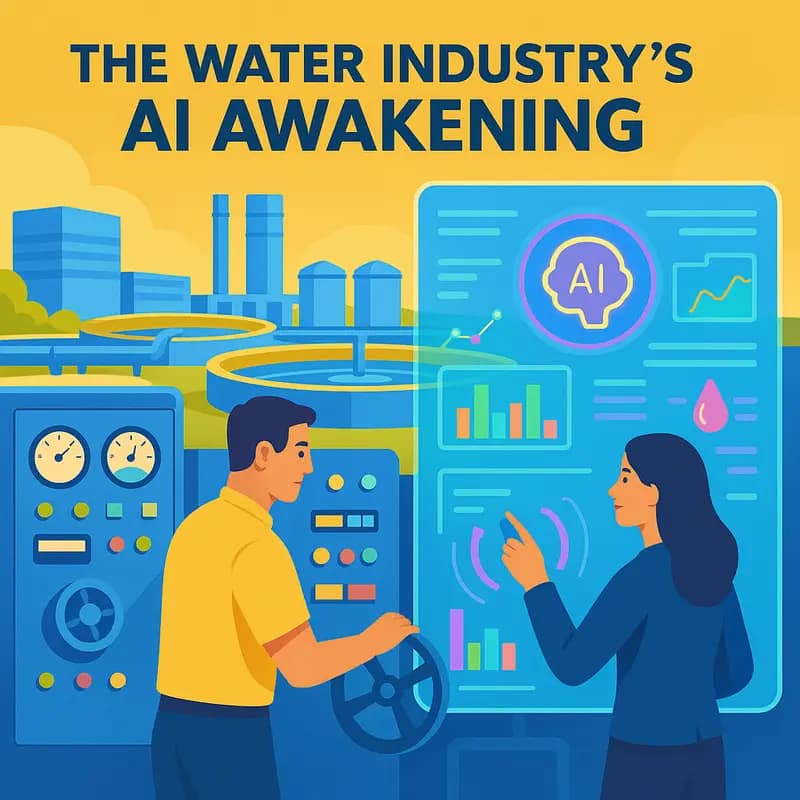
For decades, the water industry operated on traditional principles, relying on manual processes and basic automation. Yet beneath this established surface, a transformation was brewing. The convergence of big data, machine learning, and advanced analytics created the perfect conditions for an AI revolution in water management.
Artificial intelligence emerged as more than just a technological upgrade – it became an imperative response to mounting challenges. Aging infrastructure, climate volatility, and growing urban populations pushed utilities to their operational limits. The conventional approaches that served the industry for generations could no longer keep pace with these evolving demands.
The watershed moment arrived when AI demonstrated its ability to process vast amounts of operational data at unprecedented speeds. Advanced algorithms began detecting subtle patterns in water usage, predicting equipment failures before they occurred, and optimizing treatment processes in real-time. What once required days of analysis could now be accomplished in seconds, with greater accuracy and insight.
This technological leap forward wasn’t just about speed – it fundamentally transformed how water utilities approach decision-making. Rather than reacting to problems, operators gained the ability to anticipate and prevent issues before they impacted service. This proactive capability revolutionized everything from leak detection to water quality monitoring.
Perhaps most significantly, AI broke down the data silos that had long plagued the industry. By integrating information from multiple sources – from weather forecasts to customer usage patterns – utilities gained a holistic view of their operations. This comprehensive perspective enabled smarter resource allocation, more efficient maintenance scheduling, and improved customer service.
While the technology itself was revolutionary, the real transformation came from how it empowered water professionals. AI tools augmented human expertise rather than replacing it, allowing operators to make better-informed decisions and focus on strategic priorities rather than routine tasks. This partnership between human insight and machine intelligence created new possibilities for innovation and efficiency across the water sector.
Infrastructure Intelligence

Artificial intelligence is transforming how utilities monitor, maintain, and optimize their water infrastructure networks. By analyzing vast streams of sensor data, AI algorithms detect subtle patterns that signal potential issues long before they become critical failures.
Advanced leak detection exemplifies this capability. Machine learning models process acoustic sensor data to identify the unique sound signatures of different leak types, pinpointing their locations with unprecedented accuracy. Combined with pressure and flow data analysis, these systems can predict pipe failures up to weeks in advance, enabling proactive repairs that prevent costly water losses and service disruptions.
Predictive maintenance represents another breakthrough application. AI examines historical performance data, maintenance records, and real-time condition monitoring to forecast when specific assets will require service. This shifts maintenance from reactive or schedule-based approaches to precision interventions that maximize asset lifespans while minimizing downtime and costs.
The integration of computer vision adds another powerful dimension. AI-powered analysis of CCTV pipe inspection footage automatically identifies defects, assesses their severity, and tracks deterioration over time. This drastically reduces the manual effort required for infrastructure assessment while improving consistency and creating detailed digital records.
Perhaps most importantly, these AI systems continuously learn and improve. Each new data point refines their predictive models, making them increasingly accurate at distinguishing normal variations from genuine warning signs. The algorithms adapt to the unique characteristics of different infrastructure networks, delivering customized insights that account for local conditions, usage patterns, and asset configurations.
This intelligence-driven approach to infrastructure management represents a fundamental shift from traditional practices. Rather than responding to failures or following rigid maintenance schedules, utilities can now make data-driven decisions that optimize their operations across multiple dimensions – from resource allocation to capital planning. The result is more reliable service delivery, reduced losses, and better stewardship of critical infrastructure assets.
The ROI of Water AI
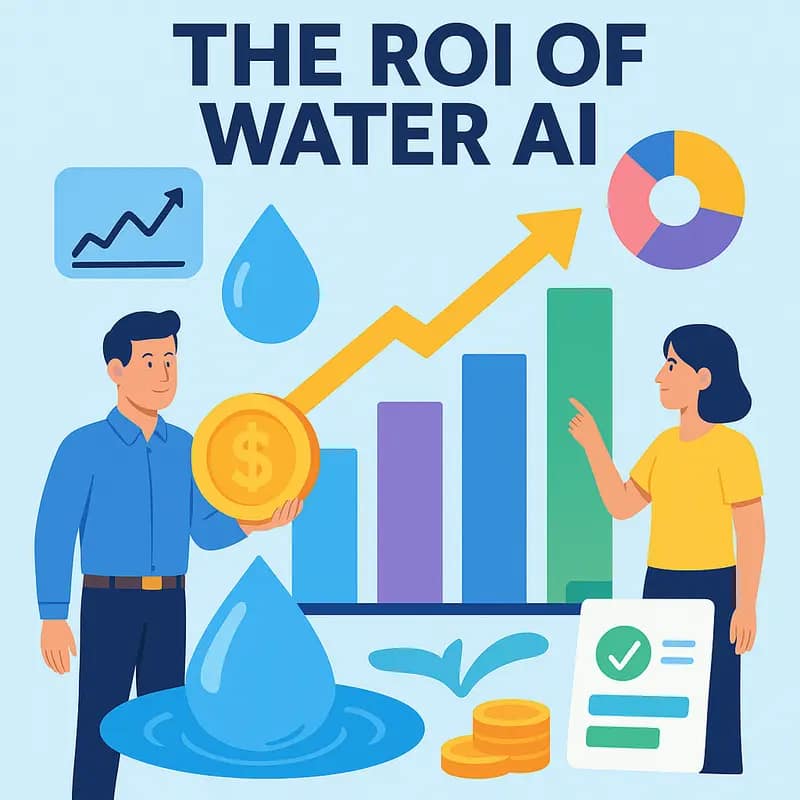
Implementing artificial intelligence in water operations delivers measurable financial returns through multiple value streams. A comprehensive analysis reveals how AI investments pay for themselves while generating ongoing operational savings and new revenue opportunities.
Operational cost reductions form the foundation of AI’s ROI proposition. Advanced predictive maintenance algorithms reduce equipment failures by up to 70%, cutting both repair costs and operational disruptions. Energy optimization through AI delivers 15-25% savings on power consumption – often a utility’s largest operating expense. These efficiencies alone typically recover initial AI investments within 12-18 months.
Beyond direct savings, AI creates new revenue potential through enhanced service delivery. Smart leak detection systems can save utilities up to 136 trillion liters annually, dramatically reducing non-revenue water losses. AI-powered customer service platforms improve collection rates while reducing support costs through automated issue resolution.
Risk mitigation represents another critical ROI factor. AI’s predictive capabilities help prevent catastrophic infrastructure failures that could cost millions in emergency repairs and regulatory penalties. Advanced monitoring ensures regulatory compliance while optimizing chemical usage and reducing environmental incidents that could trigger fines.
The workforce multiplier effect further amplifies returns. AI automation handles routine tasks, allowing skilled staff to focus on high-value activities. A single operator can now monitor entire networks, while AI assists in complex decision-making through real-time analytics and scenario modeling.
Perhaps most importantly, AI investments appreciate over time. As systems process more data, their predictive accuracy improves, generating compounding efficiency gains. Integration with other digital systems creates synergistic benefits across operations. This technological foundation also positions utilities to rapidly adopt future AI innovations, protecting their competitive advantage.
Through this multi-faceted ROI profile, water AI consistently delivers returns exceeding traditional infrastructure investments. For forward-thinking utilities, the question is no longer whether to implement AI, but how quickly they can scale these proven solutions across their operations.
Sustainable Solutions Through Smart Technology
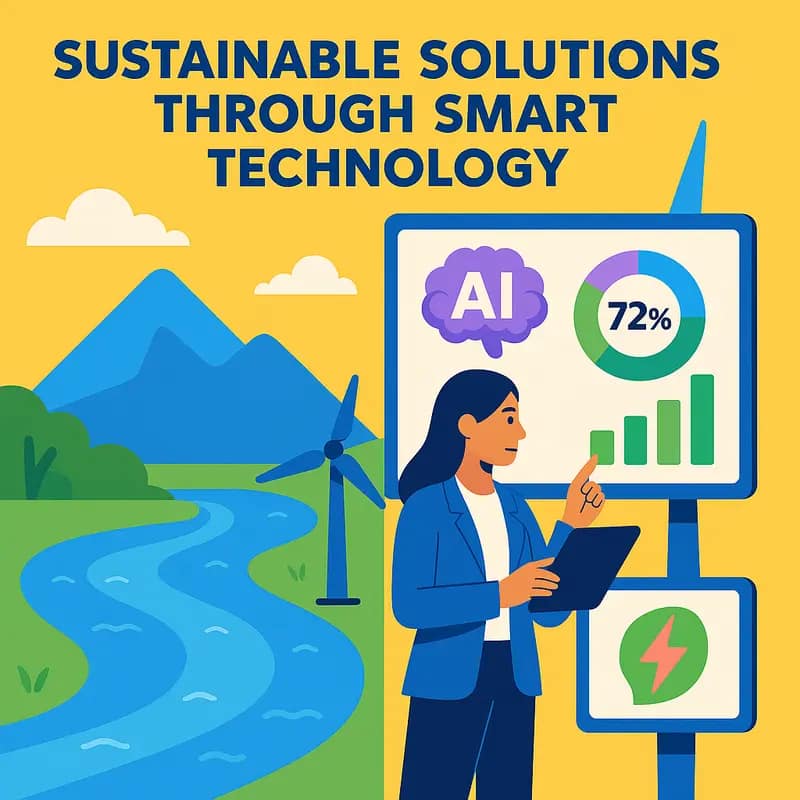
Artificial intelligence is fundamentally transforming how water utilities approach environmental sustainability while maintaining operational excellence. By leveraging advanced algorithms and machine learning capabilities, AI systems continuously optimize treatment processes, reducing energy consumption and chemical usage without compromising water quality standards.
Predictive analytics enables utilities to anticipate equipment maintenance needs before failures occur, preventing costly emergency repairs and minimizing system downtime. This proactive approach not only extends asset lifespans but also reduces the environmental impact of emergency interventions and replacement parts manufacturing.
Particularly noteworthy is AI’s role in managing water loss through intelligent leak detection. By analyzing flow patterns, pressure data, and historical maintenance records, AI systems can identify potential leaks with unprecedented accuracy, allowing utilities to address issues before they escalate into major water losses or infrastructure damage.
The technology’s ability to process vast amounts of real-time data enables dynamic treatment adjustments based on incoming water quality, weather conditions, and demand patterns. This granular control results in optimal chemical dosing, reduced energy consumption, and enhanced treatment efficiency. For example, AI-driven automation can adjust aeration intensity in wastewater treatment based on actual oxygen demand, potentially reducing energy usage by 25-40% while maintaining treatment standards.
Beyond operational efficiencies, AI systems contribute to broader sustainability goals through improved watershed management. By integrating data from multiple sources – including weather forecasts, soil sensors, and water quality monitors – these systems help utilities make informed decisions about resource allocation and environmental protection measures.
The environmental benefits extend to waste reduction as well. AI-powered process optimization minimizes the production of treatment by-products and sludge, while predictive maintenance reduces the waste associated with premature equipment replacement. This holistic approach to sustainability demonstrates how smart technology can align operational efficiency with environmental stewardship, creating a more resilient and sustainable water infrastructure.
Real-World Implementation Success Stories
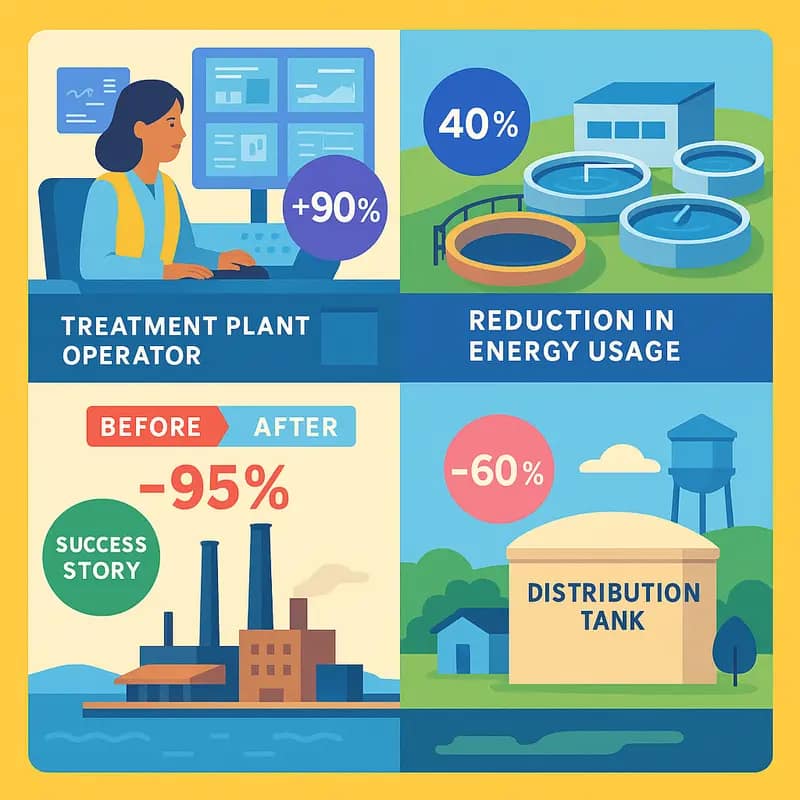
The transformative power of AI in water management is perhaps best illustrated through the landmark achievements of forward-thinking utilities that have embraced this technology. A mid-sized utility in the American Southwest exemplifies how AI-driven solutions can revolutionize operations. By implementing advanced machine learning algorithms for leak detection and pressure management, they reduced non-revenue water losses by 42% within 18 months while cutting energy consumption by 27%.
In Northern Europe, a major metropolitan water provider deployed AI to optimize their treatment processes and chemical dosing. The system analyzes real-time water quality data, weather patterns, and historical performance metrics to make precise adjustments. This implementation has resulted in a 31% reduction in chemical usage and improved effluent quality compliance from 92% to 99.5%.
Perhaps most impressive is the case of an Australian utility that integrated AI across its entire network. Their system now predicts maintenance needs with 94% accuracy, schedules preventive repairs, and automatically adjusts operations based on demand forecasting. Emergency repairs have decreased by 65%, while customer satisfaction scores have risen by 40%. The utility estimates annual savings of $3.2 million in operational costs.
A particularly noteworthy success story comes from Asia, where a coastal city’s water authority implemented AI to manage its desalination operations. The system optimizes energy consumption based on multiple variables including weather conditions, grid pricing, and water demand. This implementation has reduced energy costs by 23% while increasing plant availability by 15%.
These success stories share common elements: thorough preparation, clear objectives, and strong stakeholder engagement. They demonstrate how AI can simultaneously address multiple challenges – from operational efficiency to environmental sustainability – while delivering measurable returns on investment. Moreover, they highlight how AI solutions can scale and adapt to diverse operating environments, providing a blueprint for other utilities considering similar transformations.
As explored in How to save time, money and water thanks to 92% accurate leak detection, these implementations represent just the beginning of AI’s potential in revolutionizing water management practices.
Future-Proofing Water Operations
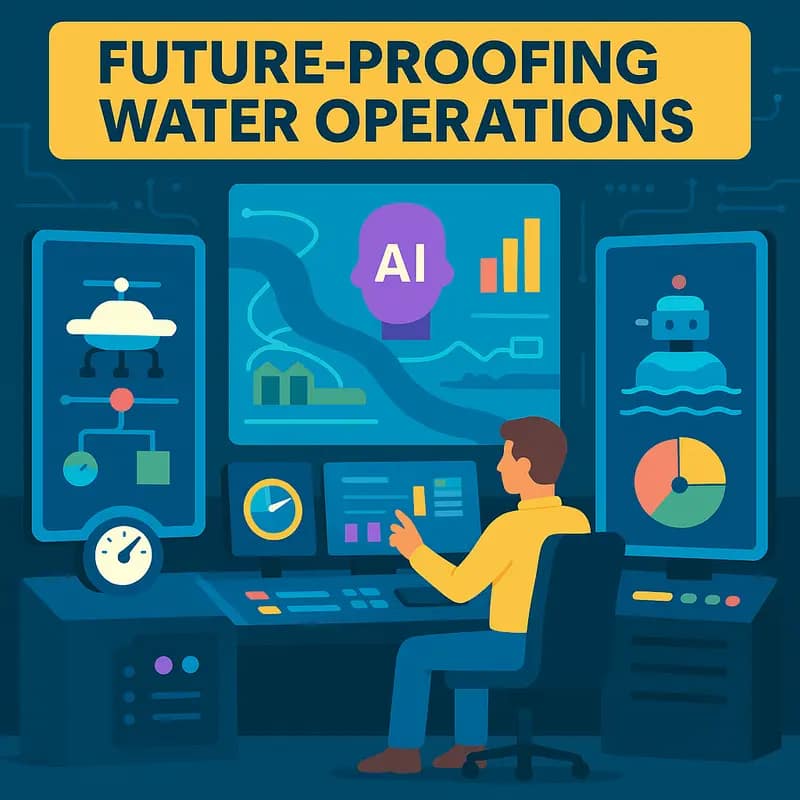
Artificial intelligence platforms are transforming water utilities from reactive organizations into predictive powerhouses capable of anticipating and addressing challenges before they materialize. This evolution in operational capability represents a fundamental shift in how utilities approach water management.
Predictive maintenance algorithms analyze vast streams of sensor data to detect subtle patterns that precede equipment failures. By identifying these early warning signs, utilities can schedule maintenance during planned downtimes rather than responding to emergency breakdowns. This proactive approach typically reduces maintenance costs by 25-30% while extending asset lifespans.
Advanced AI systems also enable dynamic optimization of treatment processes. Machine learning models continuously adjust chemical dosing, pump speeds, and other operational parameters based on real-time water quality data and predicted demand patterns. This optimization not only improves treatment efficiency but also reduces energy consumption and chemical usage.
Perhaps most importantly, AI platforms are helping utilities build resilience against emerging challenges. Climate change modeling capabilities allow operators to simulate various scenarios and develop adaptive strategies. Whether facing extended droughts, intense storms, or shifting demographics, utilities can test response plans virtually before implementing them.
The platforms’ ability to integrate data from multiple sources – weather forecasts, population trends, infrastructure conditions, and water quality metrics – provides unprecedented insight for long-term planning. This comprehensive view enables utilities to make more informed decisions about infrastructure investments and resource allocation.
Cybersecurity represents another critical aspect of future-proofing operations. AI systems continuously monitor network activity for potential threats while automatically implementing security protocols to protect sensitive operational data and control systems. This vigilance is essential as water infrastructure becomes increasingly connected and digitized.
By embracing these AI capabilities, utilities are not just preparing for known challenges – they’re building adaptable systems capable of identifying and responding to unforeseen threats. This flexibility and intelligence will prove crucial as the water sector faces increasingly complex operational demands in the decades ahead.
Integration and Implementation Roadmap
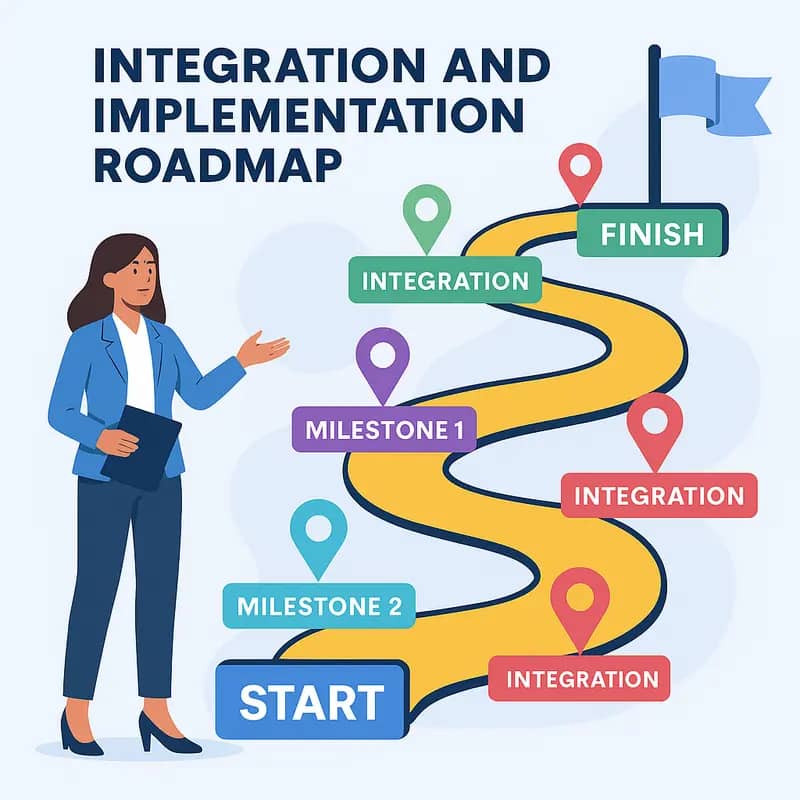
Successfully integrating AI solutions into water utility operations requires careful planning and a systematic approach. The journey begins with a comprehensive assessment of existing infrastructure, data availability, and operational pain points. This foundation enables utilities to identify high-impact areas where AI can deliver immediate value while building toward long-term transformation.
The first critical step is establishing a robust data infrastructure. Modern SCADA systems, IoT sensors, and operational databases must be properly integrated and standardized to create a reliable data pipeline. Without quality data as a foundation, even the most sophisticated AI models will fail to deliver meaningful insights.
Once the data foundation is solid, utilities should start with focused pilot projects in areas like predictive maintenance, energy optimization, or water quality monitoring. These initial projects serve as proof points while allowing staff to develop familiarity with AI-driven operations. Success metrics should be clearly defined upfront, with baseline measurements established to quantify improvements.
Staff training and change management are equally vital for successful implementation. Operations teams need both technical training on new systems and broader education about how AI augments human decision-making. Creating internal champions who understand both the technology and utility operations helps drive adoption across the organization.
Scaling beyond pilot projects requires a well-defined governance framework. This includes protocols for model validation, performance monitoring, and continuous improvement. Regular audits ensure AI systems remain accurate and aligned with operational goals. As highlighted in how to make hydraulic modeling so easy that even you will want to use it, user-friendly interfaces and clear workflows are essential for sustained engagement.
Finally, utilities must develop a long-term roadmap that balances quick wins with strategic capability building. This includes planning for infrastructure upgrades, identifying future use cases, and establishing partnerships with technology providers. Regular assessment of outcomes helps refine the implementation strategy while demonstrating value to stakeholders.
The key is maintaining momentum while being methodical. By following a structured approach focused on data quality, staff enablement, and measured expansion, utilities can successfully transform operations through AI adoption.
The Human Element: AI-Enhanced Water Management
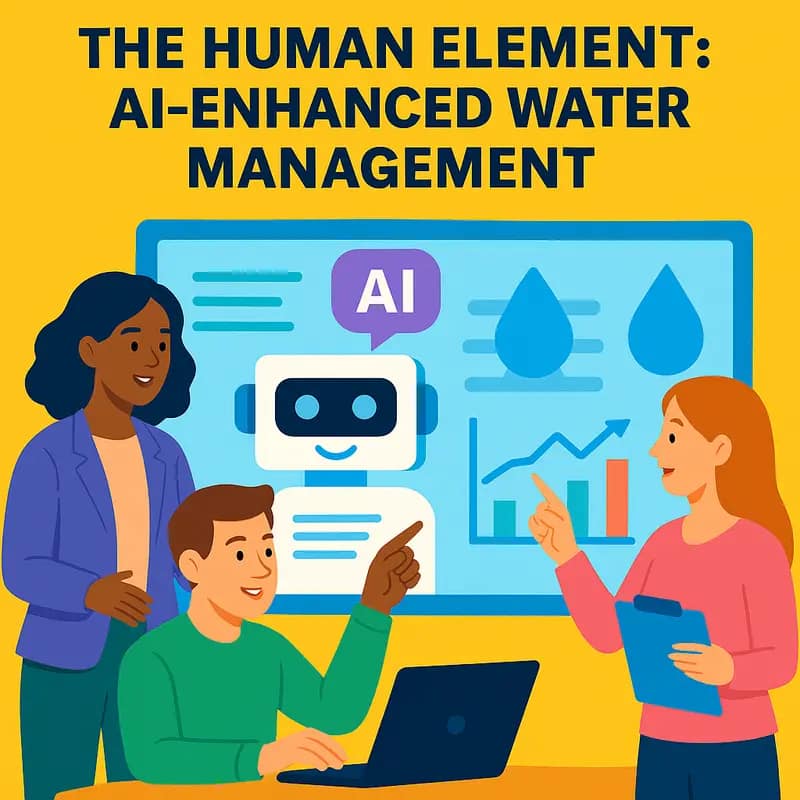
At the intersection of artificial intelligence and human expertise lies the future of water management. Rather than replacing water professionals, AI serves as a powerful tool that amplifies human capabilities and creates new opportunities for innovation and growth within the industry.
AI systems excel at processing vast amounts of data from sensors, meters, and historical records – a task that would overwhelm even the most dedicated human operator. By rapidly analyzing these data streams, AI can identify subtle patterns and anomalies that might otherwise go unnoticed. However, the true value emerges when this analytical power combines with human insight and experience.
Water industry professionals bring contextual understanding, practical knowledge, and nuanced decision-making capabilities that AI cannot replicate. Their expertise in regulatory requirements, community needs, and system operations remains essential. AI augments these skills by providing data-driven recommendations, predictive maintenance alerts, and optimization strategies that help professionals make more informed decisions.
The synergy between AI and human operators manifests in several ways. Treatment plant operators can leverage AI to monitor multiple process parameters simultaneously while focusing their attention on critical adjustments and troubleshooting. Engineers can use AI-powered modeling tools to explore various design scenarios more efficiently, applying their judgment to select the most practical and cost-effective solutions. Utility managers can harness AI insights to develop proactive maintenance strategies while maintaining their crucial role in stakeholder engagement and long-term planning.
Perhaps most importantly, AI systems can handle routine tasks and data analysis, freeing water professionals to focus on strategic initiatives, innovation, and relationship building. This shift enables utilities to provide better service while creating more engaging career opportunities for water industry professionals.
As discussed in How to cleverly embrace the digital craze in the water industry, success in this AI-enhanced landscape requires a balanced approach that values both technological capabilities and human expertise. The future of water management lies not in replacing humans with machines, but in creating powerful partnerships that leverage the strengths of both.
The Genesis of Turing

The convergence of mounting water infrastructure challenges and rapid advances in artificial intelligence catalyzed the birth of Turing. As aging water systems struggled with efficiency, sustainability, and resilience, a team of water industry veterans and AI specialists recognized an unprecedented opportunity to revolutionize water management through intelligent automation.
Drawing inspiration from Alan Turing’s foundational work in computer science, the founding team envisioned a future where AI could augment human expertise in operating complex water systems. They saw how machine learning could process vast amounts of sensor data to detect patterns, predict failures, and optimize operations in ways that would be impossible for human operators alone.
The early development focused on creating a flexible AI architecture that could adapt to diverse water infrastructure contexts while maintaining reliability and transparency. The team spent months embedded with utilities, studying operator workflows and decision-making processes to ensure their solutions would complement rather than replace human judgment.
A pivotal early insight was recognizing that successful AI implementation in water systems required more than just technical excellence – it demanded deep domain expertise and careful consideration of real-world operational constraints. The founders built a platform that could bridge the gap between cutting-edge AI capabilities and practical water management needs.
Rather than pursuing a one-size-fits-all approach, Turing’s development prioritized modularity and configurability. This allowed the platform to start with focused applications in areas like leak detection and energy optimization before expanding to more complex use cases. The measured approach helped build trust with conservative water utilities while providing crucial validation of the core technology.
As early pilot projects demonstrated compelling results, Turing began attracting attention from forward-thinking water leaders who saw the potential to transform their operations. The founding vision of AI-empowered water management was becoming reality, setting the stage for broader industry adoption.
AI Architecture for Water Systems
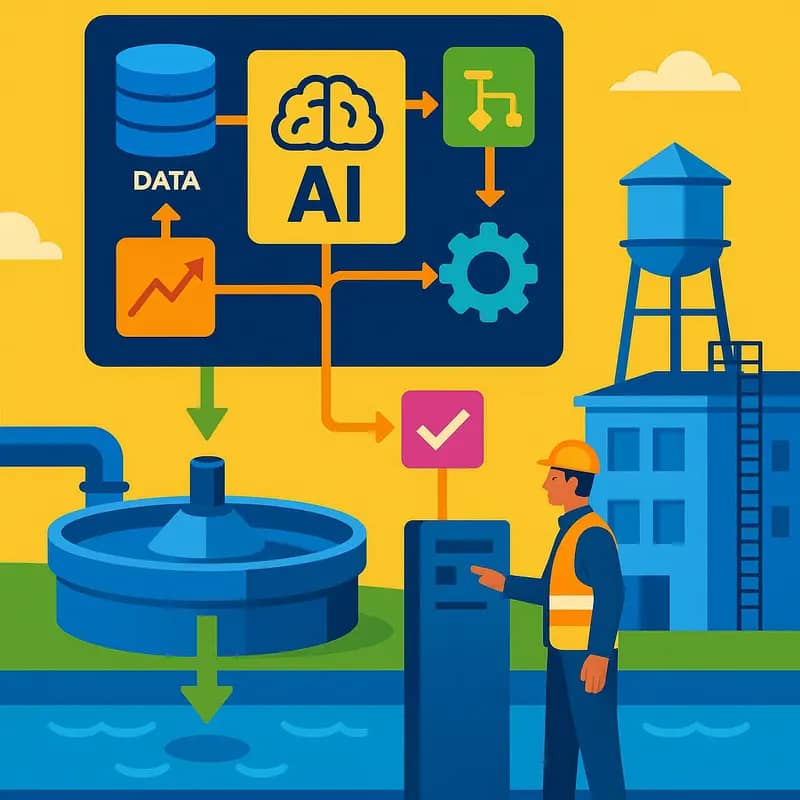
At the core of modern water infrastructure management lies an intricate AI architecture that seamlessly integrates multiple layers of machine learning capabilities. This technical foundation combines advanced neural networks with domain-specific water system modeling to create a robust framework for predictive analytics and operational optimization.
The architecture begins with a data ingestion layer that processes inputs from diverse sources – flow meters, pressure sensors, water quality monitors, and SCADA systems. These heterogeneous data streams undergo sophisticated pre-processing and normalization before feeding into the AI engine. A key innovation in this approach is the implementation of edge computing capabilities that enable real-time processing at sensor locations, reducing latency and bandwidth requirements while ensuring data integrity.
The central AI engine employs a hybrid model architecture that combines physics-based system modeling with data-driven machine learning. This dual approach allows the system to leverage established hydraulic principles while adapting to emerging patterns and anomalies. The neural network topology is specifically designed to handle the temporal nature of water system data, utilizing Long Short-Term Memory (LSTM) networks that excel at capturing long-term dependencies in time-series data.
A distinctive feature of this architecture is its ability to operate under uncertainty. The system implements probabilistic modeling techniques that quantify confidence levels in predictions, enabling operators to make risk-aware decisions. This proves particularly valuable in scenarios involving infrastructure maintenance scheduling and emergency response planning.
The architecture also incorporates a federated learning framework that enables knowledge sharing across different water utilities while maintaining data privacy. This collaborative approach accelerates the learning process and improves model robustness without compromising sensitive operational data.
As highlighted in how to take better decisions through machine learning in water infrastructure, the system’s success relies heavily on its ability to translate complex AI outputs into actionable insights for operators. The architecture therefore includes an advanced visualization layer that presents predictions and recommendations through an intuitive interface, making sophisticated AI capabilities accessible to water professionals regardless of their technical background.
Predictive Analytics in Action
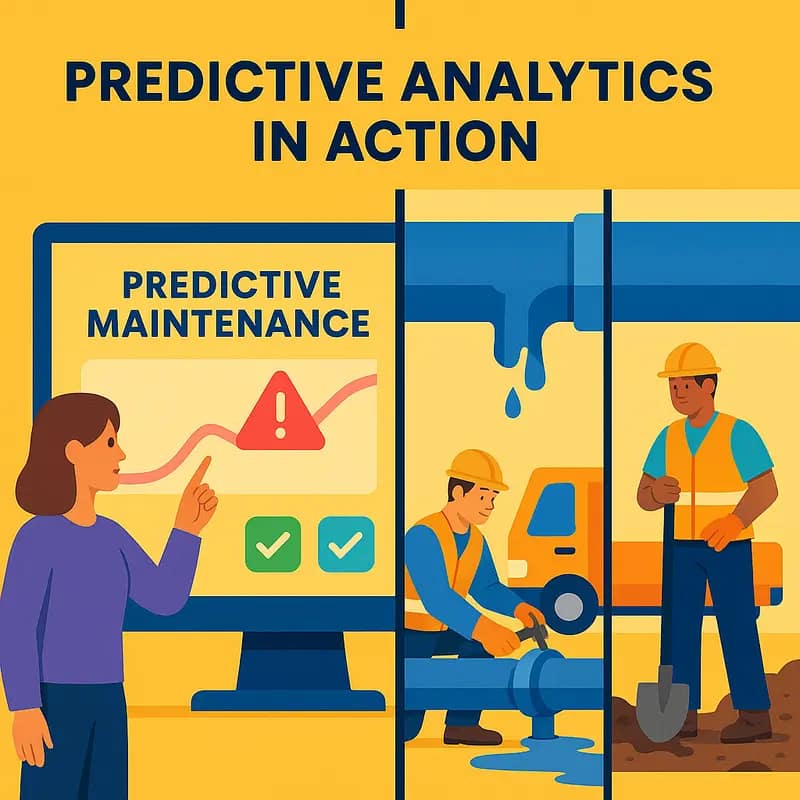
Sophisticated predictive analytics have transformed how water utilities identify and prevent system failures before they occur. By analyzing vast streams of sensor data through advanced machine learning models, operators can now detect subtle patterns that signal impending equipment malfunctions or infrastructure weaknesses.
Consider a real-world application where pressure sensors throughout a distribution network feed continuous data into an AI system. The predictive algorithms learn to recognize minute variations that typically precede pipe failures. This early warning capability has helped utilities reduce emergency repairs by up to 40% while extending asset lifespans.
Predictive maintenance scheduling represents another powerful use case. Rather than relying on fixed maintenance intervals, AI systems analyze equipment performance data to determine the optimal timing for preventive work. One utility deploying this approach decreased unplanned downtime by 35% while reducing maintenance costs by 25%.
The technology’s impact extends beyond physical infrastructure to treatment processes. By monitoring water quality parameters and correlating them with historical treatment outcomes, predictive systems help operators proactively adjust chemical dosing and process controls. This optimization has enabled treatment plants to maintain consistently high water quality while reducing chemical usage by up to 20%.
Perhaps most importantly, these predictive capabilities are changing how utilities allocate their limited resources. Instead of spreading maintenance efforts evenly across their networks, they can now focus on the assets most likely to fail. This data-driven prioritization ensures maximum impact from every maintenance dollar spent.
The evolution continues as systems become more sophisticated in correlating multiple data streams. For instance, combining weather forecasts with historical performance data helps utilities anticipate and prepare for weather-related challenges before they materialize. As noted in a recent analysis of water innovation trends, this proactive approach marks a fundamental shift from reactive to predictive operations in the water sector.
Digital Twin Technology

Digital twin technology represents a quantum leap in water infrastructure management by creating virtual replicas of physical water networks. These sophisticated digital models integrate real-time sensor data, historical performance metrics, and advanced simulation capabilities to deliver unprecedented systems insight and control.
At the heart of this technology lies a continuous feedback loop between physical and virtual environments. High-precision sensors deployed throughout water networks stream data on flow rates, pressure levels, water quality parameters, and equipment status to cloud platforms. There, AI algorithms process this information to maintain an exact digital counterpart that mirrors the real-world system’s behavior and conditions.
These virtual replicas enable operators to run complex what-if scenarios without risking actual infrastructure. Teams can simulate the impacts of different operational strategies, test responses to potential emergencies, and optimize system settings – all in a risk-free digital environment. The insights gained directly inform real-world decision-making and operational adjustments.
Beyond simulation capabilities, digital twins serve as powerful predictive tools. By analyzing patterns in historical and real-time data, they can forecast potential issues before they materialize. This predictive power allows utilities to shift from reactive maintenance to proactive optimization, preventing failures rather than responding to them.
The technology’s impact extends to long-term planning and infrastructure investment. Digital twins help utilities evaluate proposed system modifications, assess capacity requirements, and optimize capital improvement projects. This data-driven approach ensures infrastructure investments deliver maximum value while minimizing risks.
Perhaps most importantly, digital twins democratize system knowledge. Rather than relying on the expertise of a few veteran operators, detailed system understanding becomes accessible to entire teams through intuitive visual interfaces. This shared operational awareness enhances collaboration and accelerates problem-solving across organizations.
As explored in How to cleverly embrace the digital craze in the water industry, the water sector’s digital transformation requires both technological innovation and cultural adaptation. Digital twin technology exemplifies this dual evolution, combining cutting-edge modeling capabilities with new approaches to system management and decision-making.
ROI and Economic Impact
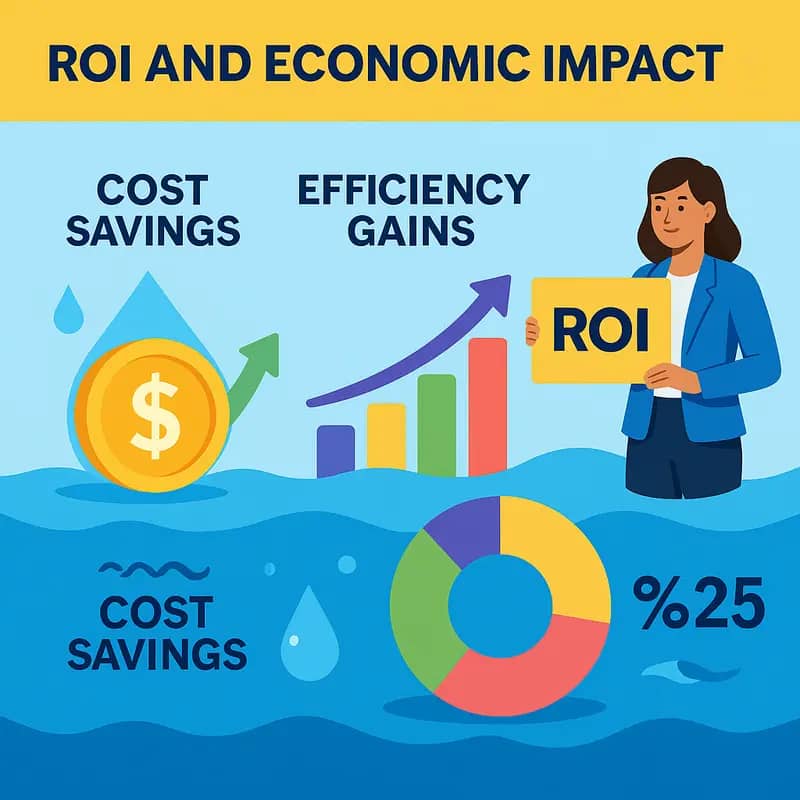
The implementation of AI solutions in water utilities delivers substantial financial returns through multiple value streams. Analysis of early adopters reveals operational cost reductions averaging 15-20% within the first year of deployment, primarily through predictive maintenance and optimization of energy consumption.
A clear pattern emerges when examining specific cost centers. Chemical dosing optimization typically yields 8-12% savings through real-time adjustment based on water quality parameters. Energy costs, often representing 30-40% of operational expenses, can be reduced by up to 25% through AI-driven pump scheduling and process optimization.
Perhaps most significantly, AI solutions dramatically reduce non-revenue water losses. Smart leak detection and pressure management systems have demonstrated potential savings of up to 136 trillion liters annually, translating to millions in recovered revenue for utilities.
The workforce efficiency gains are equally compelling. AI-powered systems automate routine monitoring and adjustment tasks, allowing utilities to redeploy skilled personnel to higher-value activities. This optimization typically results in a 20-30% increase in workforce productivity without reducing headcount.
The investment payback period varies by implementation scope but averages 12-18 months for comprehensive deployments. Utilities implementing AI solutions report ROI ratios between 3:1 and 5:1 over a five-year period, with some achieving even higher returns in specific use cases.
Beyond direct cost savings, these systems generate significant value through improved asset longevity. Predictive maintenance extends equipment life cycles by 20-30%, reducing capital replacement costs and improving infrastructure resilience. This preventive approach helps utilities avoid costly emergency repairs and service interruptions.
Risk mitigation represents another crucial economic benefit. AI-driven early warning systems help prevent regulatory compliance violations, avoiding potential fines and reputational damage. The improved operational visibility also supports more informed capital planning decisions, ensuring investments target the areas of greatest need and potential return.
Implementation and Integration
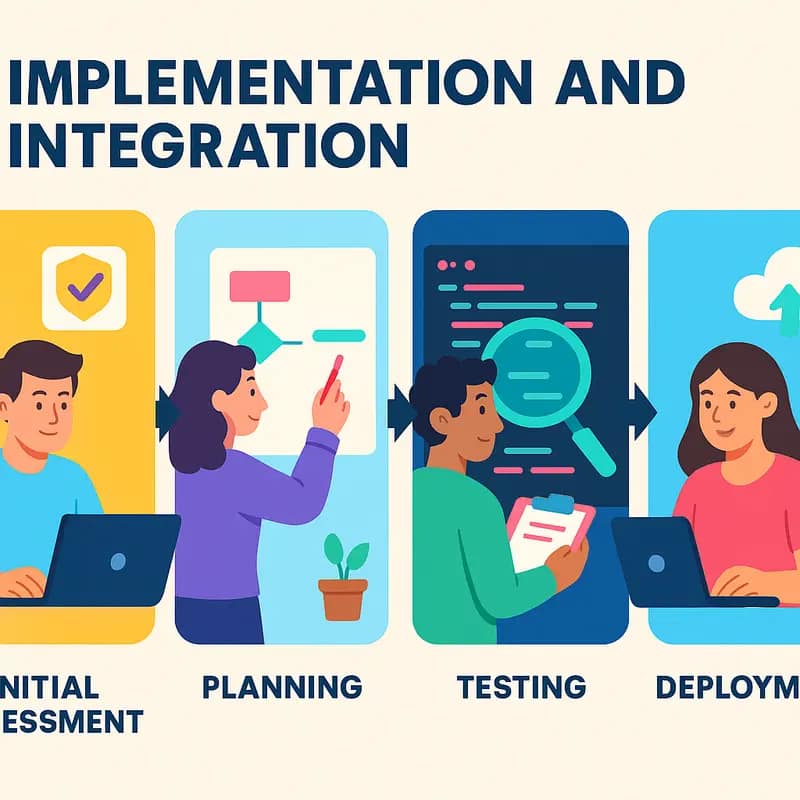
Successful AI implementation in water utilities requires a methodical approach that addresses both technical and human factors. The journey begins with a comprehensive assessment of existing infrastructure and processes to identify integration points and potential obstacles.
The first critical step involves preparing the data foundation. Utilities must audit their data sources, clean historical datasets, and establish robust data collection protocols. This groundwork enables AI systems to deliver accurate insights and recommendations. Learn more about data preparation fundamentals.
Integration with legacy systems demands careful architectural planning. Modern AI solutions utilize standardized APIs and protocols to connect with SCADA systems, sensors, and databases. A phased rollout approach allows utilities to test integrations in controlled environments before full-scale deployment. Key systems are upgraded incrementally to minimize disruption while maintaining operational continuity.
Staff training represents another crucial implementation pillar. The focus should be on developing both technical competency and confidence in working alongside AI systems. Hands-on training sessions allow operators to understand how the AI makes decisions and when human oversight is needed. Creating internal champions who can support their peers accelerates adoption across the organization.
Change management must address common concerns about job security and shifting roles. Clear communication about how AI augments rather than replaces human expertise helps build trust. Regular feedback sessions during implementation enable quick identification and resolution of challenges while fostering a culture of continuous improvement.
Successful integration also requires updating standard operating procedures and governance frameworks. New protocols should clearly define roles, responsibilities, and escalation paths. Regular audits ensure the AI system continues to meet performance targets while maintaining compliance with regulatory requirements.
By taking a holistic approach that encompasses technology, people, and processes, utilities can maximize the benefits of AI implementation while minimizing disruption to their operations.
Future Innovations

The water industry stands at the precipice of an AI-driven transformation that will redefine system management capabilities. Building on current implementations, the development pipeline focuses on advancing predictive analytics and autonomous decision-making to unprecedented levels.
Deep learning algorithms are being enhanced to process increasingly complex data streams from IoT sensors, enabling more nuanced anomaly detection and predictive maintenance. These systems will anticipate equipment failures days or weeks before they occur, allowing utilities to optimize maintenance schedules and prevent service disruptions.
The next generation of AI solutions will introduce dynamic resource optimization that automatically adjusts treatment processes based on real-time water quality data, weather forecasts, and consumption patterns. This advancement promises to reduce chemical usage by up to 30% while maintaining consistent water quality.
Perhaps most excitingly, developments in natural language processing will revolutionize how operators interact with control systems. Voice-activated interfaces and augmented reality displays will provide instant access to system data, maintenance procedures, and AI-powered recommendations. These innovations will dramatically reduce the learning curve for new staff while empowering veteran operators with enhanced decision-making tools.
As explored in this analysis of water innovation acceleration, integration of blockchain technology will enable unprecedented transparency in water quality monitoring and regulatory compliance. Smart contracts will automate reporting processes and create immutable records of water quality data.
The pipeline also includes developments in edge computing architecture that will enable real-time processing of sensor data directly at treatment facilities. This distributed approach will reduce latency in critical control decisions while enhancing system resilience.
Crucially, these innovations are being developed with a focus on backward compatibility and modular implementation. This approach ensures utilities can adopt new capabilities incrementally without disrupting existing operations, creating a smooth transition path toward increasingly sophisticated automation.
Case Studies and Success Stories
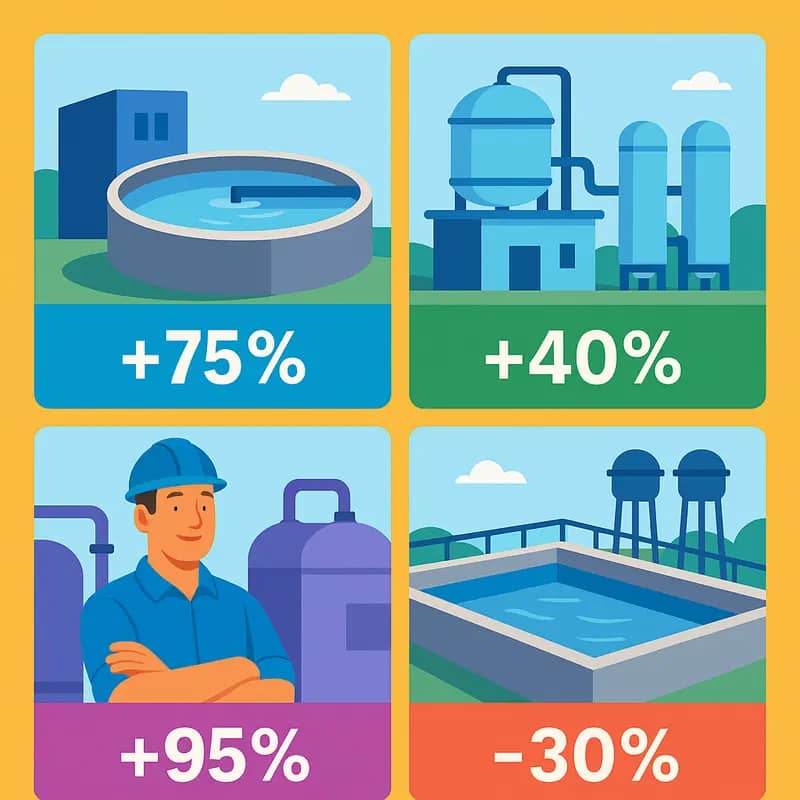
The transformative impact of AI-powered water management solutions is best illustrated through real-world implementations that have delivered measurable results. The Metropolitan Water District of Southern California achieved a remarkable 30% reduction in energy consumption across their treatment facilities by implementing advanced AI-driven optimization algorithms. The system continuously analyzes operational data to adjust treatment processes in real-time, resulting in annual cost savings of $3.2 million while maintaining exceptional water quality standards.
In Singapore, the Public Utilities Board deployed AI-enhanced predictive maintenance capabilities across their distribution network. The system processes data from thousands of IoT sensors to detect potential equipment failures before they occur. Within the first year, they reduced unexpected downtime by 45% and cut maintenance costs by 28%. More importantly, they prevented several major service disruptions that would have affected hundreds of thousands of residents.
A mid-sized utility in Colorado demonstrates how smaller operations can also achieve transformative results through AI adoption. By implementing AI-driven leak detection, they reduced their non-revenue water losses from 15% to just 5% within 18 months. The system’s machine learning algorithms analyze pressure data and acoustic sensors to pinpoint leaks with 92% accuracy, allowing for precise and efficient repairs.
In Australia’s drought-prone regions, several utilities have implemented AI-powered demand forecasting and dynamic pricing models. The system analyzes weather patterns, historical usage data, and demographic trends to optimize water distribution and encourage conservation. One utility reported a 25% reduction in peak demand and improved customer satisfaction scores after implementation.
These success stories share common themes: significant operational cost savings, improved service reliability, and enhanced environmental sustainability. The key to success in each case was not just the technology itself, but the thoughtful integration with existing operations and focus on clear, measurable objectives. As these implementations mature, they continue to discover new optimization opportunities, demonstrating the long-term value proposition of AI in water management.
Final words
As we’ve explored throughout this deep dive into Turing’s AI revolution in water management, the future of our industry is not just about implementing new technology – it’s about reimagining what’s possible. The convergence of artificial intelligence with traditional water management practices has opened doors to efficiency, sustainability, and innovation that were previously unimaginable. Turing’s solutions demonstrate that AI isn’t just a tool; it’s a paradigm shift that’s creating new opportunities for water professionals at every level. From infrastructure optimization to predictive maintenance, from cost savings to environmental stewardship, the impact of this technology is both immediate and far-reaching. For water entrepreneurs, executives, and investors, the message is clear: the water industry’s AI revolution is not on the horizon – it’s here, and Turing is leading the charge. Those who embrace this change will find themselves at the forefront of the next generation of water management, while those who hesitate risk being left behind in an increasingly competitive and technologically advanced landscape.
Get the Water Sector’s Pulse weekly for free: subscribe to my Newsletter ➡️
About us
I offer (hopefully!) unique and insightful coverage of the water industry by combining my hard-earned technical expertise with engaging storytelling. If you haven’t yet, it might be time for you to subscribe to the podcast, the youtube channel and/or the newsletter!
(I’d do it if I were you, but I’m slightly biased 😉)

